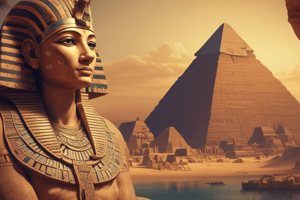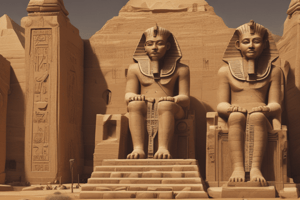Podcast
Questions and Answers
What was the primary benefit of the Nile River's annual flooding?
What was the primary benefit of the Nile River's annual flooding?
- Bringing nutrient-rich silt for agriculture (correct)
- Providing transportation for trade and commerce
- Creating a natural barrier against invaders
- Facilitating the construction of pyramids
What was the purpose of the pyramids, according to ancient Egyptian beliefs?
What was the purpose of the pyramids, according to ancient Egyptian beliefs?
- To store grain and other agricultural products
- To provide a means for the pharaoh's soul to ascend to the afterlife (correct)
- To serve as tombs for pharaohs
- To symbolize the power of the pharaohs
What type of hieroglyphic symbol represents a word or sound?
What type of hieroglyphic symbol represents a word or sound?
- Logogram (correct)
- Ideogram
- Phonogram
- Pictogram
What was the primary role of pharaohs in ancient Egypt?
What was the primary role of pharaohs in ancient Egypt?
What was the significance of the Nile River in ancient Egypt?
What was the significance of the Nile River in ancient Egypt?
What was the name of the largest and oldest pyramid built for Pharaoh Khufu?
What was the name of the largest and oldest pyramid built for Pharaoh Khufu?
What was the purpose of hieroglyphics in ancient Egypt?
What was the purpose of hieroglyphics in ancient Egypt?
What was the belief about pharaohs in ancient Egypt?
What was the belief about pharaohs in ancient Egypt?
What was the role of pharaohs in maintaining the balance and order of the universe?
What was the role of pharaohs in maintaining the balance and order of the universe?
What was the significance of the Nile's course in ancient Egypt?
What was the significance of the Nile's course in ancient Egypt?
Study Notes
Geography and Environment
- The Nile River was the lifeblood of ancient Egypt, providing water, transportation, and fertile soil for agriculture.
- The Nile's annual flooding brought nutrient-rich silt, making the surrounding land suitable for farming.
- The Nile's course also facilitated trade and communication between Upper and Lower Egypt.
Pyramids
- The pyramids of Giza, built for pharaohs Khufu, Khafre, and Menkaure, are the most famous architectural achievements of ancient Egypt.
- The Great Pyramid of Giza, built for Khufu, is the largest and oldest of the three, with an original height of 481 feet.
- Pyramids were believed to provide a means for the pharaoh's soul to ascend to the afterlife.
Hieroglyphics
- Hieroglyphics were a form of writing used by the ancient Egyptians, consisting of pictorial symbols and phonetic characters.
- There were two main types of hieroglyphics: logograms (symbols representing words or sounds) and phonograms (symbols representing sounds).
- Hieroglyphics were used for various purposes, including monumental inscriptions, religious texts, and administrative documents.
Pharaohs
- Pharaohs were believed to be gods on earth, with absolute power and control over ancient Egypt.
- The pharaoh's primary role was to maintain the balance and order of the universe (ma'at).
- Pharaohs were responsible for conducting rituals, making laws, and leading the military.
Mummification
- Mummification was a complex and expensive process, reserved for wealthy and high-ranking individuals.
- The process involved:
- Removing internal organs, including the brain, liver, lungs, stomach, and intestines.
- Dehydrating the body using natron, a natural salt.
- Wrapping the body in linen bandages, often coated with resin to preserve the body further.
- Placing protective amulets and funerary objects within the wrappings.
- The goal of mummification was to preserve the physical body, ensuring the person's Ka (life force) could return to it in the afterlife.
Studying That Suits You
Use AI to generate personalized quizzes and flashcards to suit your learning preferences.
Description
Explore the fascinating history and culture of ancient Egypt, covering topics such as the Nile River, pyramids, hieroglyphics, pharaohs, and mummification. Learn about the daily life, beliefs, and customs of ancient Egyptians.




